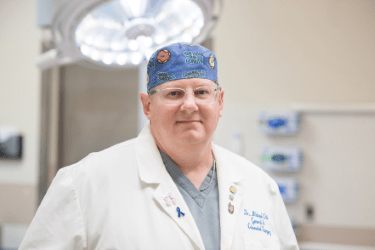Ontario’s London Health Sciences Centre has improved cancer surgery wait times by 50 per cent over the past year for non-urgent and non-emergent patients.

As of March, 90 per cent of all oncology patients receive the surgery they need within the targeted wait time, according to the urgency of their diagnosis. While patients identified as high-priority have been seen, in most cases, within their wait times, the reduction in time is impactful on a larger scale, as these improvements positively improve wait times across the health-care system.
“We know how hard it is for patients with cancer and their families to wait for surgery, and we needed to do everything we could to improve our times,” says Dr. Michael Ott, department head of the oncology department at LHSC. “This involved finding new ways to maximize our current resources and improve efficiencies – like improving our referral systems, optimizing our data used in making decisions and dedicating more operating room time for cancer surgeries.”
The patient care journey begins with initial symptom identification, followed by diagnostics, consultation with specialists and the eventual planning of surgeries.
“In the case of surgeries, each of those time points can have contributors that can delay that process,” Ott says. “When you add that all up, sometimes that becomes the wait. The first thing patients want to know when they come see me is information about their diagnosis, they want to know about prognosis. And the next thing they want to know is, ‘How soon can I get something done?’”
LHSC is the regional cancer centre responsible for inpatient and outpatient cancer care, including surgery, radiation and chemotherapy, in addition to support services and ongoing research. LHSC says in a statement that it is committed to investing resources to further enhance patient experience, from diagnosis to treatment.

Get weekly health news
Shorter wait times help remove the anxiety and some of the unknowns around a cancer diagnosis, which in turn helps patients’ families and caregivers to support them.
“It’s a massive thing to patients,” Ott says. “Everyone at the LHSC organization here that deals with cancer patients encounters it on a daily basis. So, everyone was all in on making sure that we shrink that time as much as possible.”
Now that LHSC has seen such a significant reduction in its wait times, it says it is ensuring that it’s something consistently monitored through quarterly reports from Cancer Care Ontario. In addition, LHSC monitors in-house to see whether adjustments need to be made.
“We did a number of things. We first looked at our data, looked at wait time lists and who were on the lists, how long they’ve been waiting, and what type of surgeries they were waiting for,” Ott says. “We then looked at increasing capacity in the operating room, so (LHSC) increased time to target long waiters in surgical disciplines, and oncology was highlighted.”
The team at LHSC then worked with groups of surgeons and colleges to look at their practice plans and promote things like central referral processes so everyone can get sent to the location with the shortest wait-list.
“It’s kind of a multi-pronged approach in order to facilitate decreasing that time as much as possible,” Ott says.
The Verspeeten Family Cancer Centre, formerly the London Regional Cancer Program, is a large network that provides comprehensive cancer services to approximately 1.8 million patients in southwestern Ontario. In 2023 and 2024 so far, there were nearly 300,000 outpatient visits and 7,700 new patients seen. This is one of the reasons why a reduction in wait times is so influential across the board – people can be diagnosed and treated faster.
“When we can work together as a team towards a goal like this and then see a realization of that goal, it really helps to create positive morale,” Ott says. “When you think about the physicians, nurses, everyone does this job because they care about the patient, and so if we can get people through the system quicker, that’s our goal as well.
“It feels really good to be able to do something to help patients to feel better about their treatments and diagnosis.”












Comments